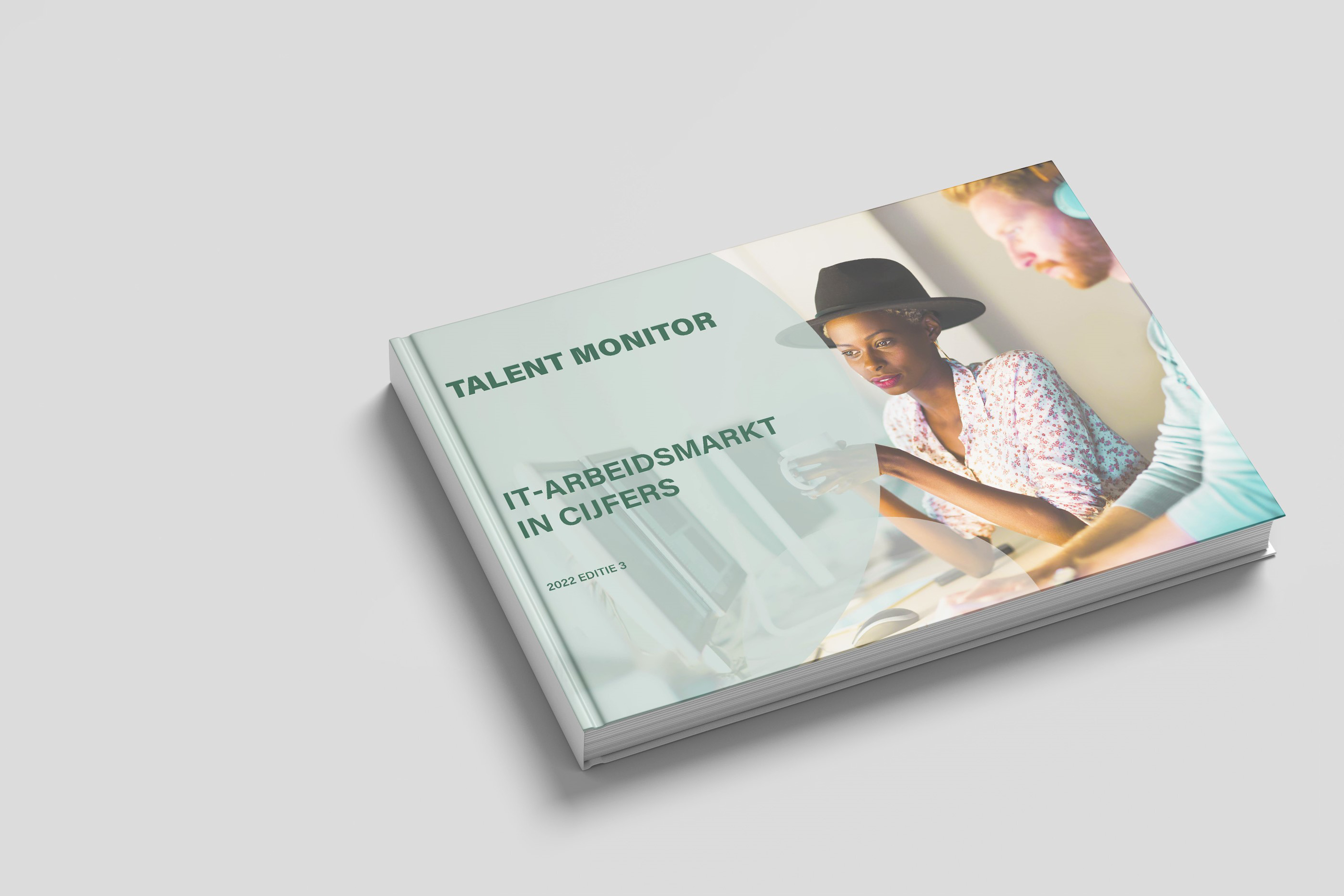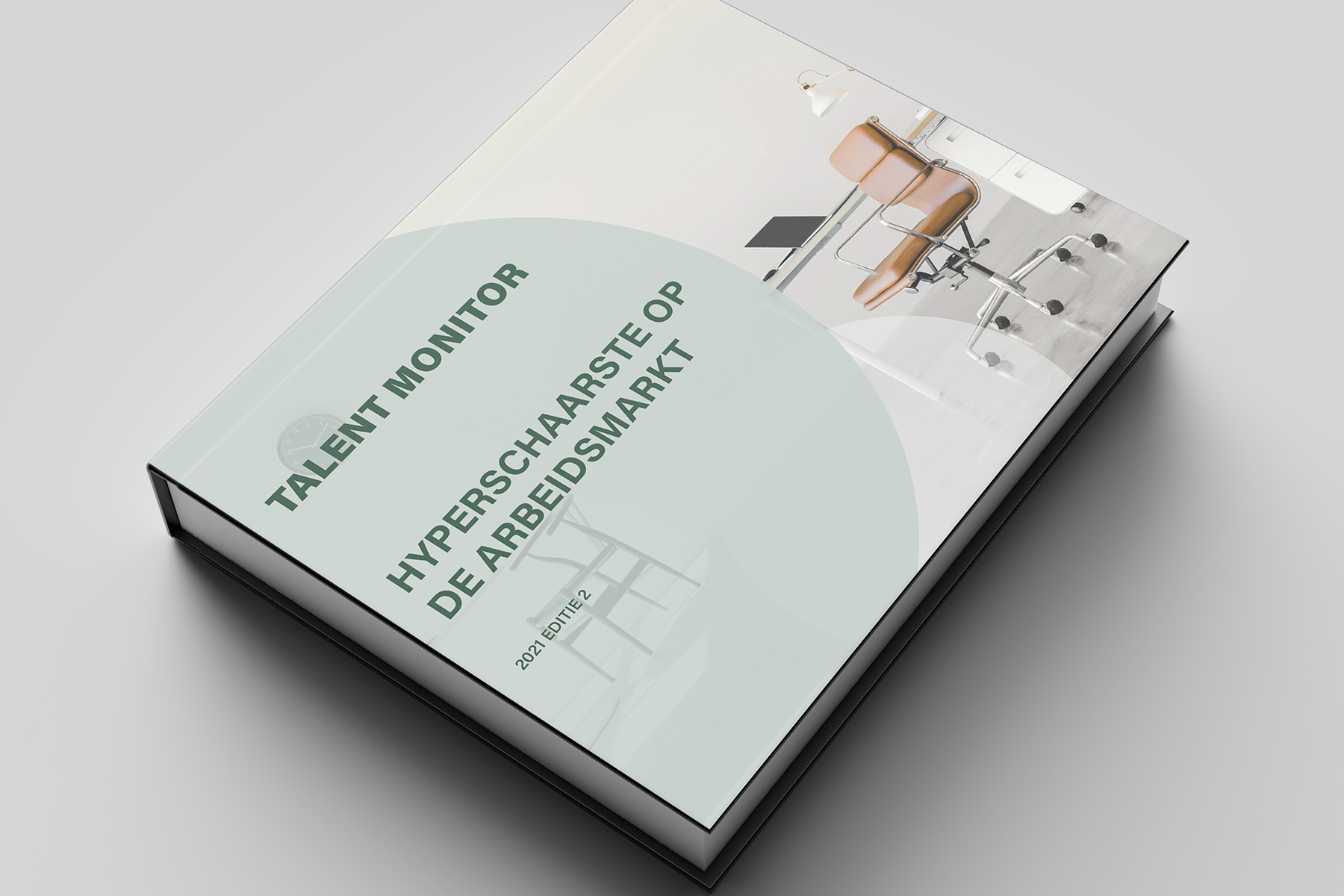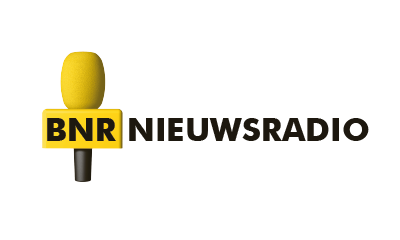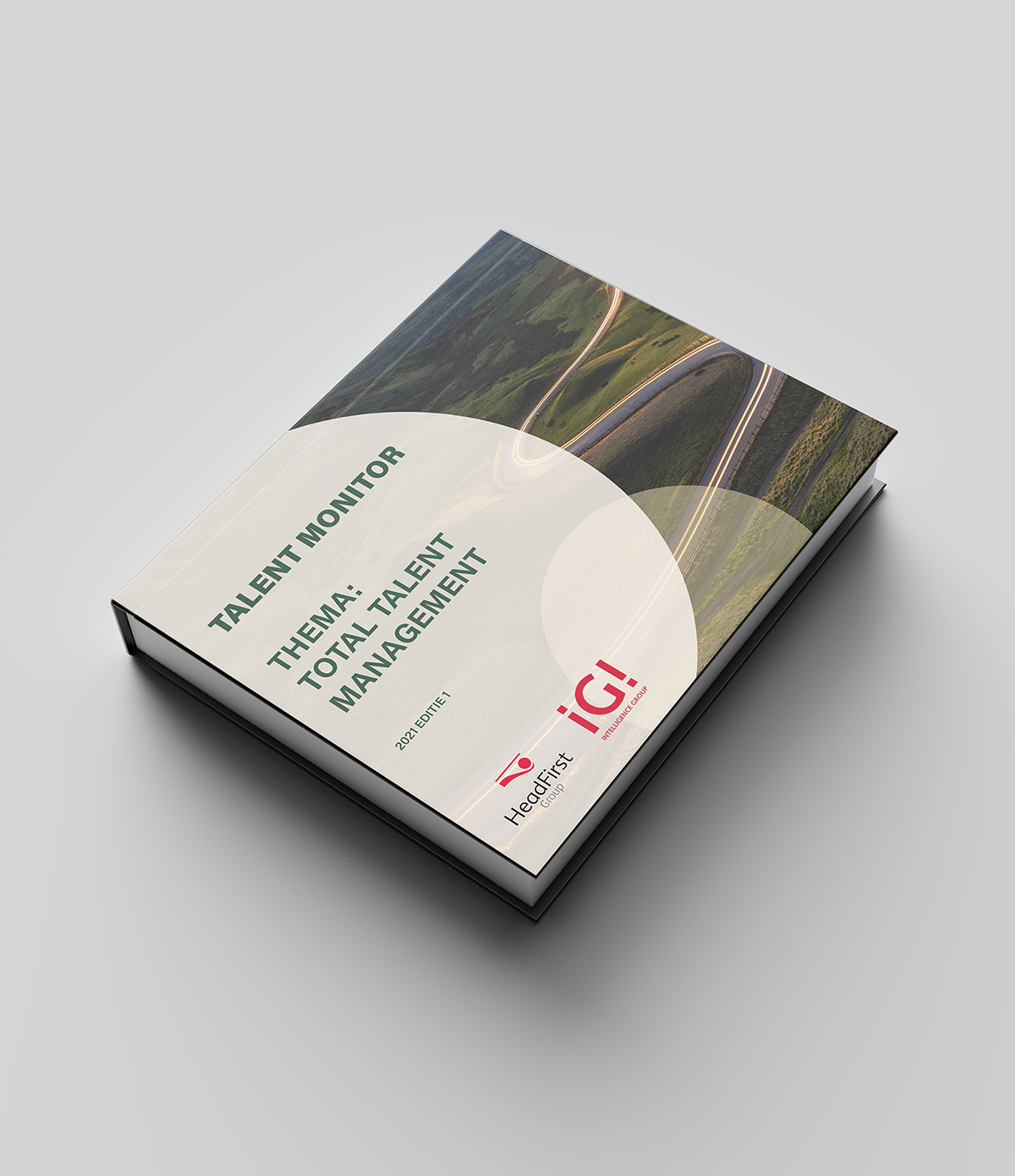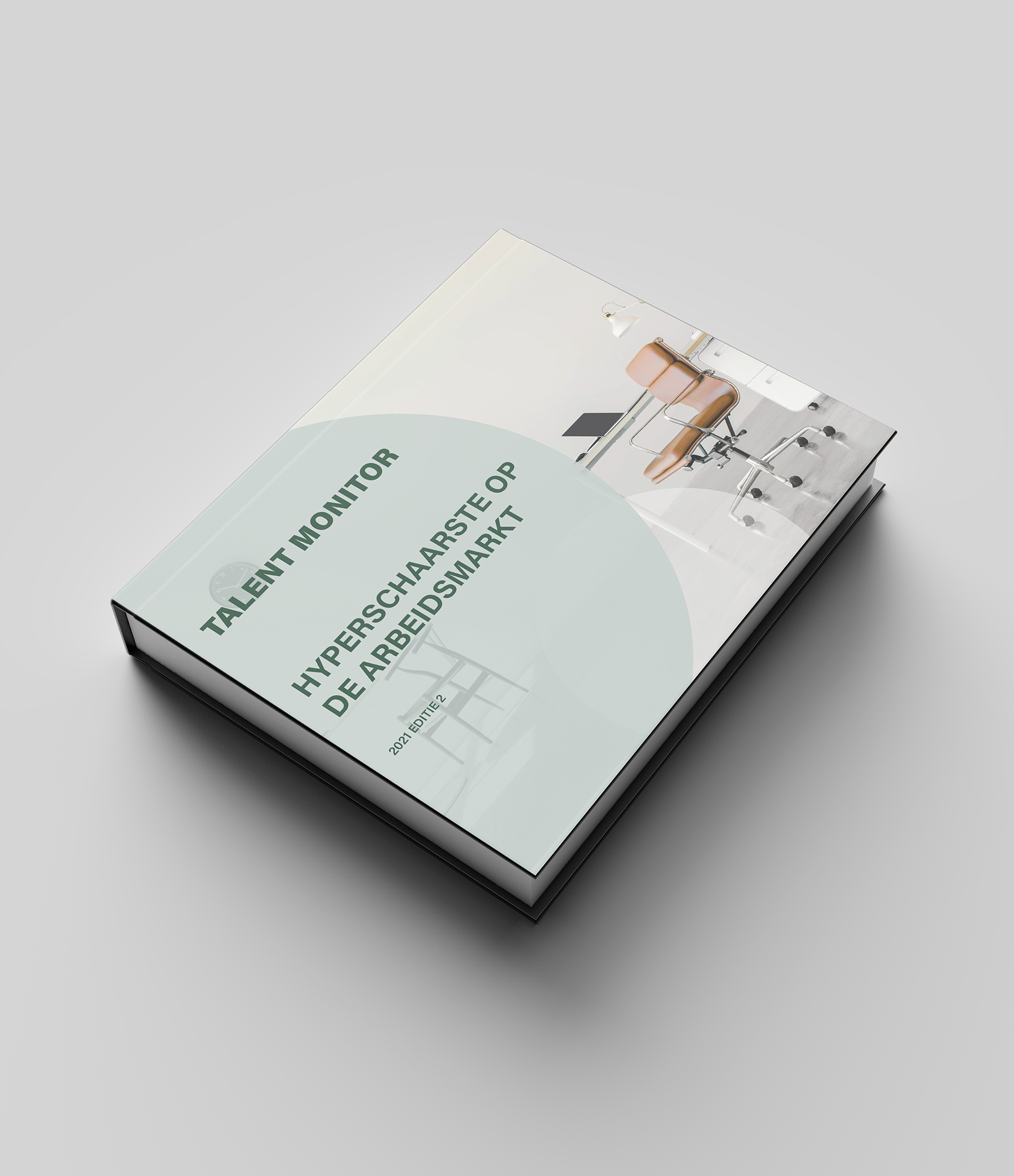Talent Monitor: update forecast rate development professionals 2022
Talent Monitor: update forecast rate development professionals 2022
In December 2021, Intelligence Group and HeadFirst Group took a major, unique step by forecasting the rate trends of temporary professionals for 2022. At the same time, we announced an interim update on the predictions made for the middle of this year. Now is the time to present these insights.
Accelerated rate hike averaging 10.3% for self-employed and secondees in 2022
Flexible workers, more specifically, self-employed workers and professionals employed by secondment agencies, have become more expensive by an average of 4.7% in the first six months of 2022. Over the whole of this year, 10.3% rate increase is expected, with inflation and scarcity being the driving forces. This is according to data and the rate forecasting model from labor market data specialist Intelligence Group and HR tech service provider HeadFirst Group. This exceeds the average agreed wage increase for permanent staff, which remained stuck at 3.1% for the first half of 2022. Read the entire press release here
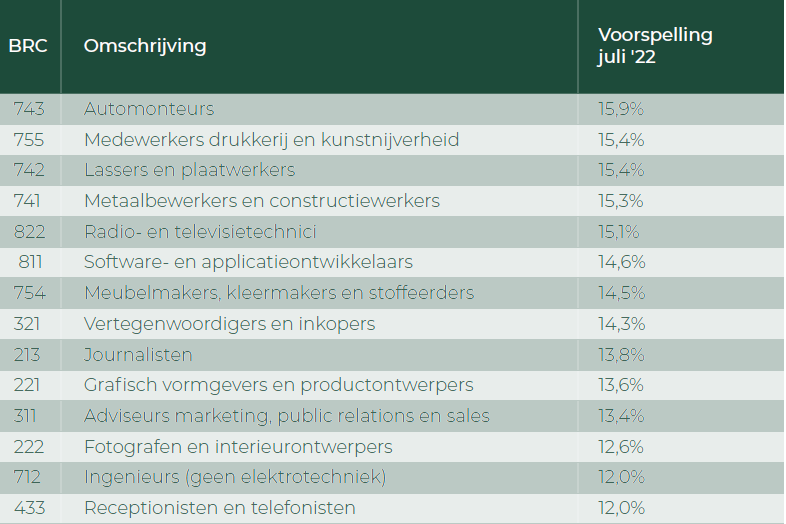
Inflation drives hourly rate up further
For this update, we analyzed the realized hourly rates of professionals - self-employed and professionals employed by secondment agencies - in the first half of 2022. Using this data, we were able to map out for 46 professional groups, within which the proportion of professionals is large, how the rate increase developed compared to the previously issued forecast for all of 2022. Motivated in part by an exceptionally scarce labor market and rocketing inflation, there are three main conclusions:
- The rate increase of professionals - practical and highly educated - averages 4.7% in the first six months of 2022.
- The hourly rate is expected to increase by an average of 10.3% by the end of the year. Still over 3% more (!) than already predicted in December 2021.
- The average agreed wage increase for permanent staff for the first half of 2022 is 3.1%. This leaves salaries behind current inflation, inflation expectations and average rate increases for professionals.
Partner
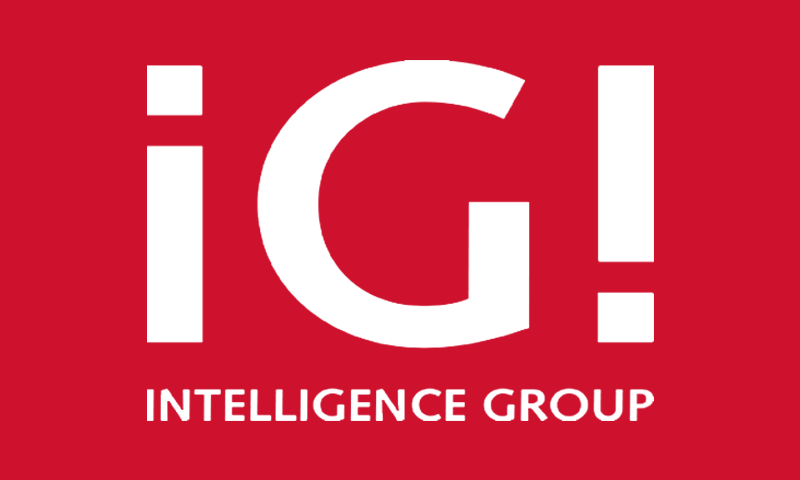
Download Talent Monitor
Other reports...
Talent Monitor: update forecast rate development professionals 2022
We compile quarterly - based on recruitment data from...
Talent Monitor: Zzp'ers: protect or set free?
We compile quarterly - based on recruitment data from...
Talent Monitor: Forecast rate development professionals 2022
We compile quarterly - based on recruitment data from...
Talent Monitor: Hyperscarcity in the labor market
We compile quarterly - based on recruitment data from...
Talent Monitor: Zzp'ers: protect or set free?
Talent Monitor: Zzp'ers: protect or set free?
We believe that exploitation in the labor market must be countered with appropriate measures, while at the same time not ignoring the large group of self-employed people who consciously choose to do business in complete freedom and have control over their own work. With the insights in this report, we hope to make a new contribution to this.
Only tens of thousands of 1.2 million self-employed work for hourly rate below 20 euros
Zzp'ers working as store assistants, childcare workers, teaching assistants, waiters or bartenders work on average at the lowest hourly rates in the Netherlands. They also have a relatively low scarcity indication, which predicts that the prospect of rate increases is limited. On the other hand, relatively few self-employed workers are active in these occupational groups, compared to the total of nearly 1.2 million. These insights were published in the Talent Monitor by HR service provider HeadFirst Group and labor market data specialist Intelligence Group.
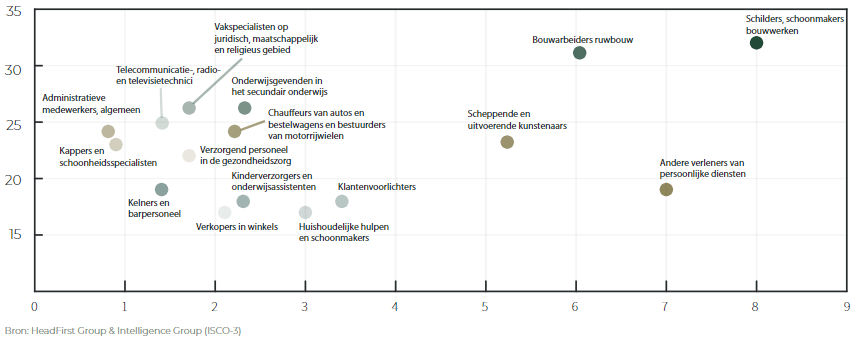
Main observations
- Self-employed people with an hourly rate of €35 or lower work mainly as domestic help and cleaners, waiters and bar staff or childcare and teaching assistants.
- In particular, the occupational groups of child care and teaching assistants and domestic helpers and cleaners seem to be the needy target groups based on the hourly rate and the prospect of rate increases.
- Specialists in the field of sports and fitness and authors, journalists and linguists can largely be found in the €36 to €70 rate group.
- Zzp'ers with an hourly rate of €70 or higher are overrepresented in professional groups such as lawyers, software and application developers and analysts, and doctors.
- At 28%, self-employed persons with an hourly rate of €35 or lower are slightly more actively looking for a (new) assignment than self-employed persons in the other two rate groups. The part that is not actively looking, but is keeping an eye on the market, at 49%, is actually smaller than the other two rate groups.
- Zzpp'ers with a lower hourly rate are more willing to go into paid employment (again) (18%). For self-employed people with an hourly rate of €70 or higher, that percentage is slightly lower, at 16%. For self-employed people with an hourly rate between €36 and €70, it stalls at 11%.
- Zzp'ers with an hourly rate of €70 or higher are approached most often by clients and intermediary agencies. Their sourcing pressure, the percentage who are approached at least once per quarter, is 67%. For freelancers with an hourly rate of €35 or lower, it is 63% and for freelancers with an intermediate hourly rate 61%.
- Zzpp'ers with an hourly rate of €35 or lower are less willing to travel far for an assignment. Half of the self-employed with an hourly rate of €70 or higher are willing to travel longer than an hour, compared with 37% of self-employed with an hourly rate of €35 or lower.
Partner

Download Talent Monitor
Previous editions
Talent Monitor: update forecast rate development professionals 2022
We compile quarterly - based on recruitment data from...
Talent Monitor: Zzp'ers: protect or set free?
We compile quarterly - based on recruitment data from...
Talent Monitor: Forecast rate development professionals 2022
We compile quarterly - based on recruitment data from...
Talent Monitor: Hyperscarcity in the labor market
We compile quarterly - based on recruitment data from...
Talent Monitor: Forecast rate development professionals 2022
Talent Monitor: Forecast rate development professionals 2022
Labor market data specialist Intelligence Group has developed a unique rate prediction model, using data from HeadFirst Group, among others. At the end of 2021, we presented the first forecast, starting an annual tradition.
Highly educated professional gains an average of 5% percent
Self-employed and seconded professionals have a big rate hike ahead in 2022. On average, a highly skilled professional can increase the hourly rate by 5 percent in 2022. The largest increases are expected within practically trained professional groups, with the machine mechanic being the outlier. He is expected to gain 44.6 percent. Across all workers - from practical to highly skilled - the average expected increase is 7 percent. Read the entire press release here
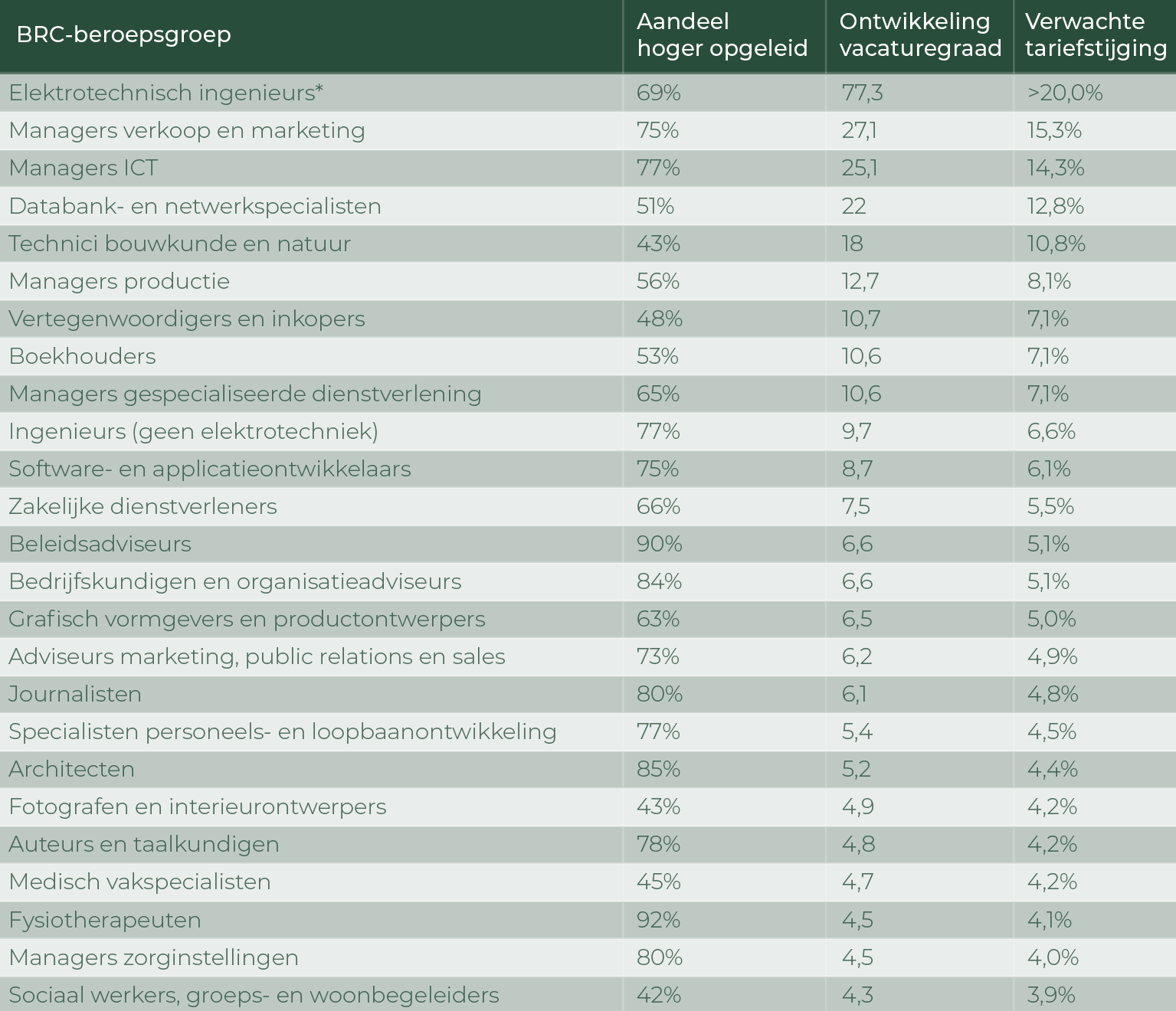
Main observations
- The average expected rate increase in 2022 is 7%. For all highly skilled professionals, the expectation is 5% and for the more practical and operational occupations (blue collar) at least 7%.
- Zooming in on the professionals segment: only among logistics managers, librarians and conservators is a rate increase not expected. The former is a scarce occupational group, but less so compared to last year. The largest rate increases are expected among electrical engineers, sales and marketing managers, ICT managers, database and network specialists, and construction and nature engineers.
- Looking at the more practical and operational segment: only among self-employed bus drivers and streetcar drivers is a small decrease expected (-1.1%). The largest increases are expected among machine mechanics, plumbers and pipe fitters, carpenters, electricians and electronics mechanics, assembly workers, agricultural and forestry workers, welders and sheet metal workers, and truck drivers, among others.
- Rate increases are primarily explained by a constant increase year-over-year of 1.8%. Sensationally, this increase is most logically explained by inflation, but that is not always the explanatory factor. A second factor is the increase or decrease in the occupational vacancy rate. As the vacancy rate decreases or increases and thus the market becomes tighter or wider compared to the previous year, the rate moves with it. These two factors, explain 90.6% of the variance in the prediction model.
Partner

Download Talent Monitor
Other reports...
Talent Monitor: update forecast rate development professionals 2022
We compile quarterly - based on recruitment data from...
Talent Monitor: Zzp'ers: protect or set free?
We compile quarterly - based on recruitment data from...
Talent Monitor: Forecast rate development professionals 2022
We compile quarterly - based on recruitment data from...
Talent Monitor: Hyperscarcity in the labor market
We compile quarterly - based on recruitment data from...
Talent Monitor: Total Talent Management
Talent Monitor: Total Talent Management
We make available each quarter - based on Intelligence Group's recruitment data and HeadFirst Group's hiring data - unique insights on labor market related themes in our 'Talent Monitor'.
Corona accelerates rise of self-employed workers
In the first edition of the Talent Monitor, we look at Total Talent Management and it becomes clear that corona is accelerating the rise of the self-employed. Scarcity in both permanent and flex is increasing and the labor market is tilting completely. You can read more about these highlights here.
Main observations
Search behavior of self-employed people
for work is much the same as employees.
Payrolling
has become ten times smaller in the last four years.
Because of the turmoil surrounding the DBA law
clients are more often choosing to use professionals through suppliers, rather than self-employed workers.
The shortage of recruiters
combined with the shortage of candidates and temporary workers, means employers must rely more on recruiting on their own.
Many temporary workers
who lost their jobs during corona, became self-employed or went into permanent employment.
Platforms
currently have little impact in bringing supply and demand of self-employed workers together. Agencies, social media and own network play a bigger role. The game changer has yet to emerge.
Download Talent Monitor
We take you through the state of the labor market and specifically the relationships between permanent and flex
Other reports...
Talent Monitor: IT labor market in figures
We make available each quarter - based on Intelligence Group's recruitment data and HeadFirst Group's hiring data - unique insights on labor market related themes in our 'Talent Monitor'.
Talent Monitor: update forecast rate development professionals 2022
We make available each quarter - based on Intelligence Group's recruitment data and HeadFirst Group's hiring data - unique insights on labor market related themes in our 'Talent Monitor'.
Talent Monitor: Zzp'ers: protect or set free?
We make available each quarter - based on Intelligence Group's recruitment data and HeadFirst Group's hiring data - unique insights on labor market related themes in our 'Talent Monitor'.
Talent Monitor: Forecast rate development professionals 2022
We make available each quarter - based on Intelligence Group's recruitment data and HeadFirst Group's hiring data - unique insights on labor market related themes in our 'Talent Monitor'.
Talent Monitor: Total Talent Management
We make available each quarter - based on Intelligence Group's recruitment data and HeadFirst Group's hiring data - unique insights on labor market related themes in our 'Talent Monitor'.
Talent Monitor: Hyperscarcity in the labor market
We make available each quarter - based on Intelligence Group's recruitment data and HeadFirst Group's hiring data - unique insights on labor market related themes in our 'Talent Monitor'.
Talent Monitor: Hyperscarcity in the labor market
Talent Monitor: Hyperscarcity in the labor market
Where TTM and scarcity go hand in hand at the moment, a nice bridge - after the first edition of the Talent Monitor in the theme 'Total Talent Management' - to put the second edition entirely in the theme of 'scarcity'. We dive into this trend and provide unique insights based on Intelligence Group's recruitment data and HeadFirst Group's hiring data.
For the first time in history hyper-scarcity in the flex market
For a while, organizations were able to afford the luxury of filling the shortage of permanent employees with temporary, external professionals. Those days are over: the flexible labor market is also in short supply on all fronts. Read the entire press release here.
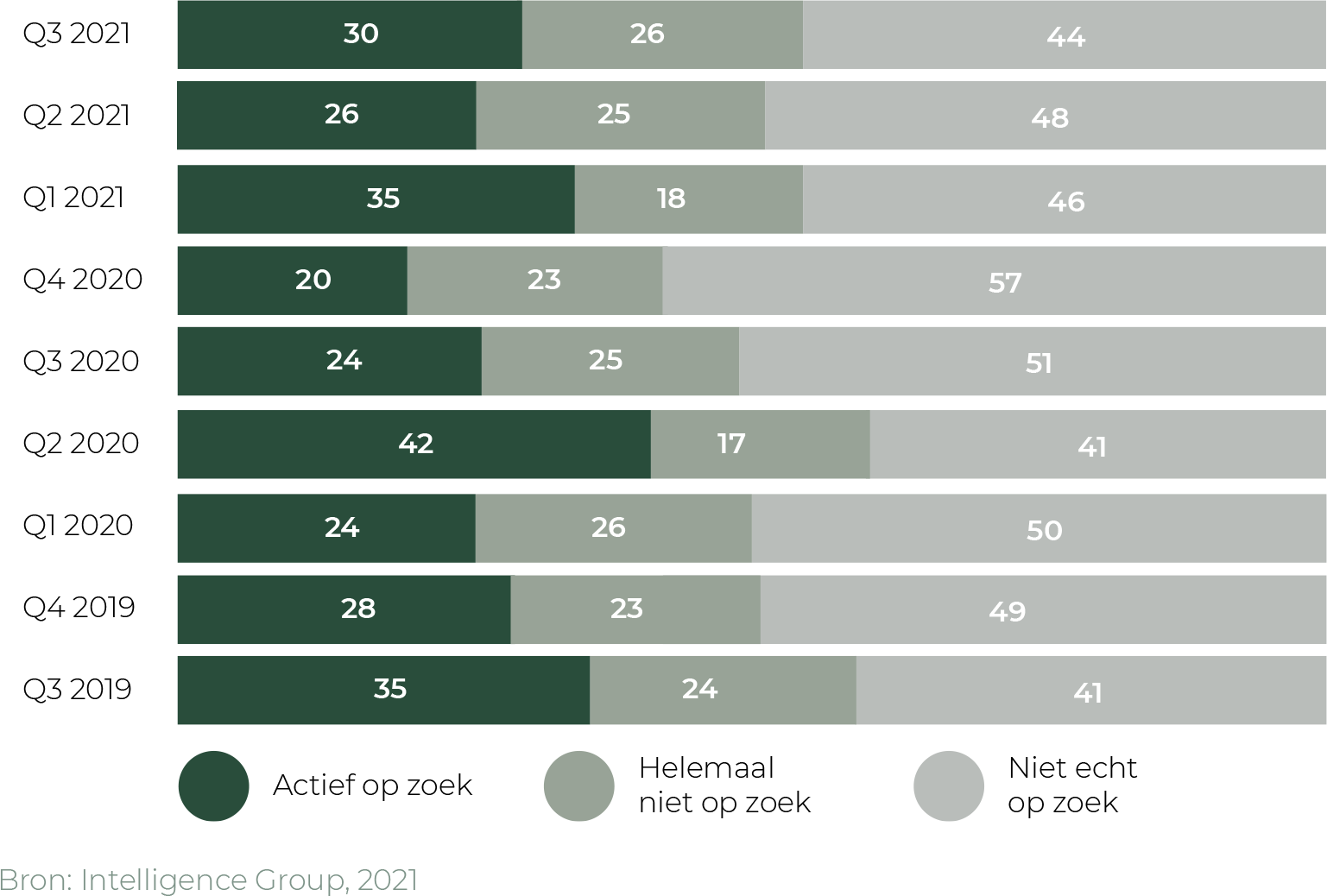
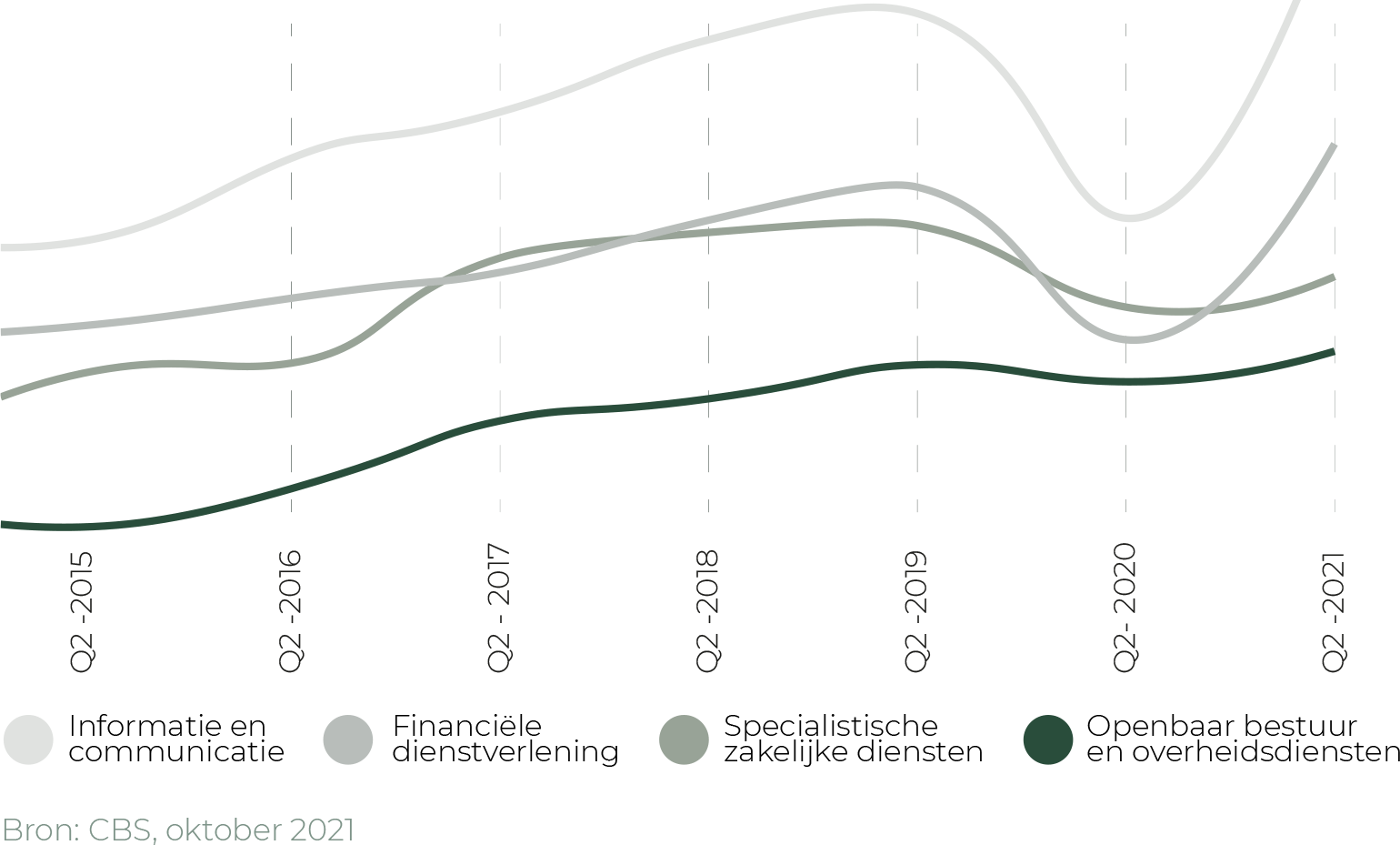
Zzp rates shoot up as inflation spikes
While inflation in the Netherlands is at its highest level in almost twenty years, a sharp dichotomy is emerging between the wages of employees and the rates of self-employed workers. The self-employed can demand considerably higher rates, while collective bargaining wages cannot keep up with price developments.
Main observations
- The proportion of active assignment seekers among self-employed workers is 26% and 30% in the last two quarters, meaning that nearly three-quarters are not looking for a new assignment, if at all.
- Assignments for highly skilled professionals receive five times fewer offers.
- Whereas in quarter 2, 71% of the highly educated and 58% of the low educated self-employed had fewer paid assignments due to corona, in the third quarter of 2021, the figure is only 27% (highly educated) and 47% (low educated).
- Sourcing pressure on self-employed to new record: nearly 7 out of 10 self-employed are approached at least once a quarter for an assignment.
- Rates of highly skilled self-employed workers are increasing from year to year between 3.5 - 7%. This increase seems to accelerate especially in the last quarters.
- Detachers respond with recruitment of new staff: 47% increase in number of vacancies between quarter 3 2020 and quarter 3 2021.
Partner

Download Talent Monitor
Previous editions
Talent Monitor: update forecast rate development professionals 2022
We compile quarterly - based on recruitment data from...
Talent Monitor: Zzp'ers: protect or set free?
We compile quarterly - based on recruitment data from...
Talent Monitor: Forecast rate development professionals 2022
We compile quarterly - based on recruitment data from...
Talent Monitor: Hyperscarcity in the labor market
We compile quarterly - based on recruitment data from...


